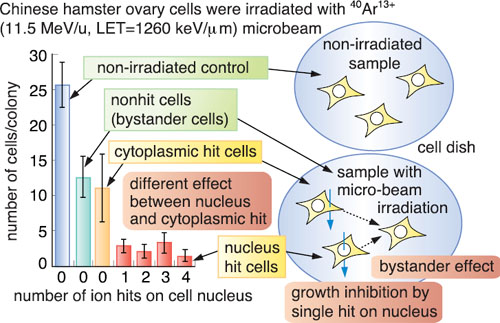The biological effect of heavy ion beam should be analyzed when utilizing its higher biological effectiveness on cancer therapy and plant breeding. Because target irradiation of heavy ion beam was not able to carry out, it was impossible to analyze the effects of heavy ion irradiation at individual cells. The targeting of cells individually with single heavy ions is a good way to solve this issue. Therefore, we established a method for irradiating individual cells using a heavy ion microbeam apparatus at JAERI-Takasaki (Fig. 6-1).
Using this system, Chinese hamster ovary cells were irradiated with an 40Ar13+ beam, after which the effects of irradiation were observed individually. Cells hit by a single argon (Ar) ion on their nucleus showed strong growth inhibition after 60 hours of post-irradiation incubation. In addition, we also observed bystander effect on the growth of non- hit cells that were co-cultured with the hit ones in the same cell dish (Fig. 6-2).
This cell targeting system will enable us to analyze the molecular mechanisms of the biological effects of heavy ion beam. We believe that the molecular analysis of the ion- hit effects including the bystander effect will contribute to the development of novel applications of heavy ion beam, such as development of more effective methods for cancer therapy and advanced techniques for ion-beam breeding. |

